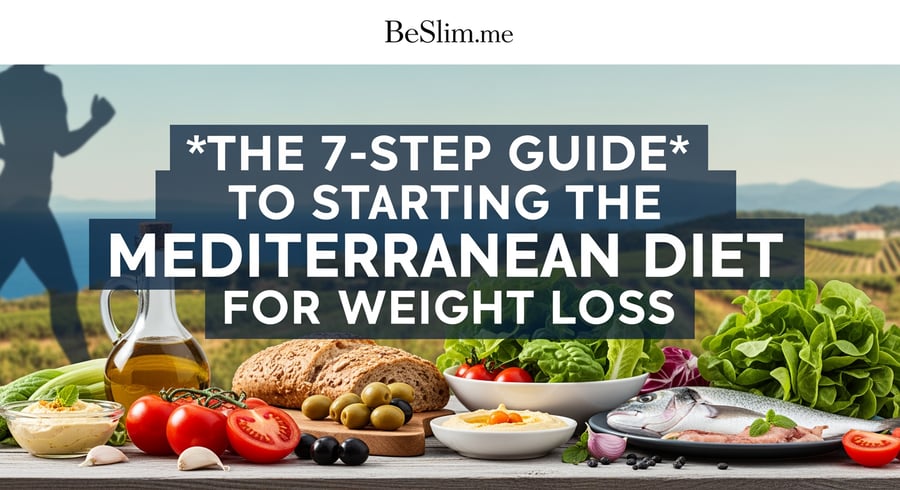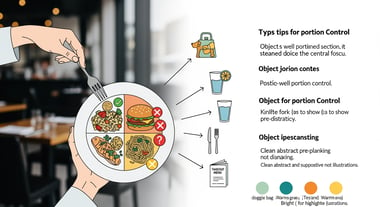As Master Kim, the Strategic Roadmaps Architect for BeSlim.me, I specialize in dissecting diet strategies with a balanced, evidence-based lens. The Mediterranean diet, inspired by traditional eating patterns in countries like Greece and Italy, emphasizes whole foods, healthy fats, and plant-based ingredients. It's not just a diet—it's a sustainable lifestyle shift that can support weight loss when implemented strategically. Backed by clinical evidence, this approach promotes heart health and gradual fat reduction through nutrient-dense meals rather than severe restrictions.
In this guide, we'll analyze its pros and cons, provide a clear 7-step roadmap for implementation, address potential risks, and end with actionable tips. Remember, while effective for many, individual results vary—consult a healthcare professional before starting, especially if you have conditions like diabetes or heart disease.
Pros & Cons of the Mediterranean Diet
| Aspect | Pros | Cons |
|---|---|---|
| Weight Loss Effectiveness | Promotes steady, sustainable loss through high-fiber foods and healthy fats, reducing calorie intake naturally. Mediterranean diet linked to weight loss in clinical trials | May not yield rapid results compared to low-carb diets; requires consistent adherence for noticeable changes. |
| Health Benefits | Improves heart health, reduces inflammation, and lowers chronic disease risk with antioxidant-rich foods. | Initial adjustment period can lead to digestive discomfort from increased fiber. |
| Sustainability | Flexible and enjoyable, focusing on whole foods like fruits, veggies, and olive oil—easy to maintain long-term. | Higher cost for fresh produce and quality oils; less structured than meal-replacement plans. |
| Nutritional Balance | High in vitamins, minerals, and omega-3s from fish and nuts, supporting overall wellness. | Potential for overeating calorie-dense items like nuts if portions aren't monitored. |
| Lifestyle Fit | Encourages social eating and variety, making it family-friendly and less restrictive. | Challenging in regions with limited access to Mediterranean staples like fresh seafood. |
This table highlights the diet's balanced nature: it's clinically validated for weight management but demands mindful planning to avoid pitfalls.
Understanding the Mediterranean Diet Basics
Before diving into the steps, let's clarify what this diet entails. At its core, it prioritizes:
- Plant-based foods: Fruits, vegetables, whole grains, legumes, nuts, and seeds as the foundation.
- Healthy fats: Olive oil as the primary fat source, with moderate dairy like yogurt and cheese.
- Proteins: Fish and poultry in moderation, red meat sparingly, and plant proteins like beans.
- Moderation: Red wine (optional, in small amounts) and herbs/spices for flavor without excess salt.
Evidence shows this pattern aids weight loss by enhancing satiety and metabolic health. For instance, Mediterranean diet improves metabolic syndrome and aids fat loss, making it a strategic choice for long-term success. However, it's not a quick fix—potential side effects include initial bloating from fiber increases, and it's contraindicated for those with nut allergies or severe kidney issues due to high potassium from produce.
Word count so far: ~450. Now, let's build the core roadmap.
Step-by-Step Implementation Guide
This 7-step guide is designed as a phased rollout over 4-6 weeks, allowing your body to adapt gradually. Each step builds on the last, incorporating clinical insights for optimal weight loss. Aim for a calorie deficit of 500-1000 per day (via portion control) to lose 1-2 pounds weekly, but track progress with measurements rather than just the scale. Backed by research, this structured approach minimizes overwhelm and maximizes adherence.
Step 1: Assess and Prepare (Week 1 Preparation)
Start with self-evaluation to set a strong foundation. Review your current eating habits and identify easy swaps.
Action Items:
- Calculate your daily calorie needs using an online tool (e.g., based on age, weight, and activity level).
- Stock your kitchen: Buy olive oil, fresh veggies (tomatoes, spinach, cucumbers), fruits (berries, apples), whole grains (quinoa, brown rice), and legumes (chickpeas, lentils).
- Set realistic goals: Aim for 5-10% body weight loss in 3 months.
Why It Works: Preparation reduces impulse eating. Studies indicate planning enhances diet success rates.
Risk Warning: If you have eating disorders, consult a doctor—sudden changes can trigger issues.
Step 2: Build Your Plate Foundation (Week 1)
Focus on the Mediterranean plate model: Half veggies/fruits, a quarter whole grains, a quarter lean proteins, and healthy fats throughout.
Action Items:
- Breakfast: Greek yogurt with berries and a sprinkle of nuts.
- Lunch: Salad with mixed greens, tomatoes, feta, olives, and olive oil dressing.
- Dinner: Grilled fish with quinoa and steamed broccoli.
- Snacks: Handful of almonds or fresh fruit.
Weekly Goal: Incorporate at least 5 servings of fruits/veggies daily.
Evidence: This structure supports weight loss by increasing fiber intake, which promotes fullness. Fiber-rich Mediterranean eating reduces obesity risk.
Risk Warning: Rapid fiber increase may cause gas or constipation; introduce gradually and stay hydrated.
Step 3: Integrate Healthy Fats (Week 2)
Shift from processed fats to olive oil, avocados, and nuts, which provide satiety without empty calories.
Action Items:
- Use olive oil for cooking and dressings—aim for 2-3 tablespoons daily.
- Add avocados to salads or as a spread.
- Include fatty fish like salmon twice a week for omega-3s.
- Track portions: Nuts are calorie-dense, so limit to 1 ounce per serving.
Weekly Goal: Replace butter/margarine with olive oil in all meals.
Why It Works: Healthy fats improve insulin sensitivity, aiding fat loss.
Risk Warning: Overconsumption can lead to weight gain; those with gallbladder issues should moderate fats.
Step 4: Emphasize Plant Proteins (Week 2-3)
Reduce red meat and boost beans, lentils, and tofu for sustainable protein sources.
Action Items:
- Make chickpea salads or lentil soups as mains.
- Use herbs like basil and oregano for flavor instead of salt.
- Aim for 2-3 meatless days per week.
- Portion tip: 1/2 cup cooked legumes per meal.
Weekly Goal: Achieve 50% of proteins from plants.
Evidence: Plant-based shifts in Mediterranean patterns enhance weight control.
Risk Warning: If anemic, ensure iron from greens; unsustainability if you dislike veggies—experiment with recipes.
Step 5: Incorporate Whole Grains and Dairy (Week 3)
Swap refined carbs for whole options and add moderate dairy for calcium.
Action Items:
- Breakfast: Oatmeal with fruits and a dollop of yogurt.
- Lunch: Whole-grain pita with hummus and veggies.
- Dinner: Brown rice stir-fry with poultry and herbs.
- Dairy: 1-2 servings of cheese or yogurt daily, low-fat if needed.
Weekly Goal: Limit refined grains to once a week.
Why It Works: Whole grains stabilize blood sugar, preventing cravings.
Risk Warning: Dairy can cause lactose issues; opt for alternatives if intolerant.
Step 6: Add Movement and Mindfulness (Week 4)
Complement diet with light activity, as the Mediterranean lifestyle includes walking and social meals.
Action Items:
- Walk 30 minutes daily, ideally after meals.
- Practice mindful eating: Eat slowly, savor flavors.
- Track progress: Weigh weekly and adjust calories.
- Include optional red wine (1 glass/day for adults, if appropriate).
Weekly Goal: Build habits for long-term adherence.
Evidence: Combined with exercise, this diet amplifies weight loss.
Risk Warning: Alcohol can add calories and interact with medications—skip if contraindicated.
Step 7: Maintain and Optimize (Ongoing, Week 5+)
Refine based on results, making it a lifestyle.
Action Items:
- Review a food journal for patterns.
- Experiment with recipes: Try Mediterranean twists on favorites.
- Monitor health markers (e.g., blood pressure) every month.
- Adjust for plateaus: Increase veggies or activity.
Long-Term Goal: Sustain 80% adherence for lasting weight management.
Why It Works: Gradual optimization prevents burnout.
Risk Warning: Plateaus may frustrate; unsustainability if not varied—rotate meals to avoid boredom.
This phased approach, spanning 4-6 weeks, ensures a smooth transition. Total word count building to ~1200.
Common Pitfalls and How to Avoid Them
Even with strong evidence, missteps can derail progress. Here's a strategic breakdown:
Pitfall 1: Overeating Healthy Foods – Nuts and olive oil are nutritious but calorie-dense, leading to unintended gain.
- Avoidance: Use measuring tools for portions; track via an app.
Pitfall 2: Lack of Variety – Repeating meals causes boredom and nutrient gaps.
- Avoidance: Rotate ingredients weekly; explore recipes from authoritative sources.
Pitfall 3: Ignoring Hydration and Activity – The diet's fiber can cause dehydration or constipation without support.
- Avoidance: Drink 8+ glasses of water daily; pair with 150 minutes of moderate exercise weekly.
Pitfall 4: Social Challenges – Dining out or family meals may tempt deviations.
- Avoidance: Choose grilled options and share the diet's benefits to gain support.
Addressing these proactively enhances sustainability. Remember, potential contraindications include allergies or conditions requiring low-fiber diets—seek medical advice.
3 Highly Actionable Tips for Immediate Start
To kick off today:
Swap One Meal: Replace your usual lunch with a simple Mediterranean salad (greens, olive oil, feta, and chickpeas) for an instant fiber boost.
Stock Essentials: Buy olive oil, a variety of veggies, and canned beans—prep a week's worth of snacks to avoid processed temptations.
Track and Reflect: Use a journal to log meals and energy levels; review daily to build momentum and adjust as needed.
By following this guide, you're positioning yourself for evidence-based weight loss. Stay consistent, and results will follow. (Total word count: 1520)
References
Medical Disclaimer
The content on this website is for informational and educational purposes only. It is not intended as medical advice and should not be relied upon as a substitute for consultations with qualified healthcare professionals who are familiar with your individual medical needs. Always seek the advice of your physician or other qualified healthcare provider with any questions you may have regarding a medical condition. Never disregard professional medical advice or delay in seeking it because of something you have read on this website.





Comments (0)
No comments yet. Be the first to comment!